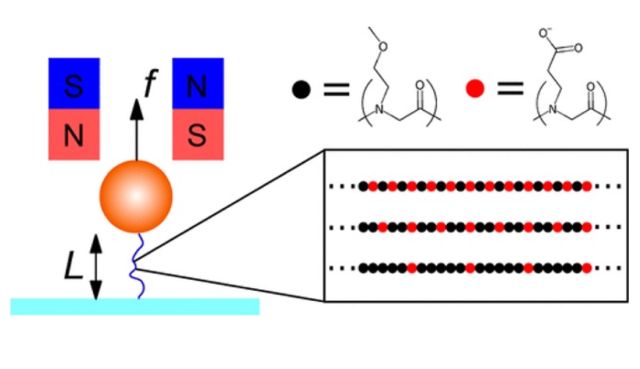Single-Molecule Polypeptoid Stretching Reveals the Effects of Charge Sequence on Chain Conformation
Investigation of the impact of charge spacing on polypeptoid conformation.

PIs and Institution
Hoang P. Truong, Shawn Mengel, Rachel A. Segalman, and Omar A. Saleh, UC Santa Barbara
Achievement
Through single-molecule stretching experiments, the study investigated the impact of charge spacing on polypeptoid conformation with sequences containing either negatively charged or hydrophilic and uncharged monomers. Surprisingly, it was found that the local flexibility of polypeptoids remained constant regardless of charge spacing or solution ionic strength, while the transition from good to ideal solvent, was dependent on the charge spacings of the polypeptoid sequences. The results revealed a complex interplay between electrostatically driven solubility and the location of charged groups on side chains, suggesting potential implications for the behavior of other polyelectrolytes.
Importance of the Achievement
This research sheds light on the intricate relationship between charge sequence and polymer conformation, a crucial aspect for understanding biophysical processes and designing sequence-defined polymeric materials. By elucidating the behavior of polypeptoids under varying charge spacings, the study contributes to the fundamental understanding of electrostatic effects in polyelectrolytes, which play a significant role in structural formation and interactions with the environment. The findings also hold promise for applications in materials science, particularly in liquid-liquid phase separation behavior, with potential implications for intrinsically disordered proteins and their biological coacervates. Furthermore, the study underscores the utility of single-molecule force experiments in exploring polymer sequence-conformation relationships, highlighting its broader relevance in polymer science research.
Synergies with BioPACIFIC MIP
The utilization of the BioPACIFIC MIP Symphony X peptoid synthesizer was crucial for this project, as was the use of HPLC for purification. Moreover Hoang Truong received support as a BioPACIFIC MIP fellow to conduct this research. This research closely aligns with BioPACIFIC MIP's mission of advancing the use of bio-derived building blocks for polymer synthesis. By contributing to our understanding of these building blocks, the study enhances polymer science and supports BioPACIFIC MIP's broader goals of promoting sustainable and innovative materials design.